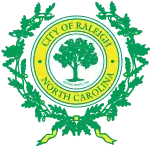Shaw University
Shaw University is a private liberal arts historically black university (HBCU) in Raleigh, North Carolina. Founded on December 1, 1865, Shaw University is the second oldest HBCU in the Southern United States, after Clark Atlanta University. It has been called the "mother of African-American colleges in North Carolina" as the founding presidents of North Carolina Central University, Elizabeth City State University, and Fayetteville State University are all Shaw alumni. The founder of Livingstone College studied at Shaw, before transferring to Lincoln University. What became North Carolina Agricultural and Technical State University was located on Shaw's campus during its first year.
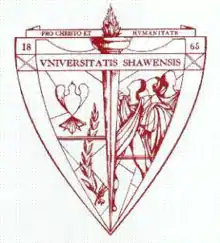 | |
| Latin: Universitatis Shawensis | |
Former names | Raleigh Theological Institute (1869-1870) Shaw Collegiate Institute (1870-1875) |
|---|---|
| Motto | Pro Christo Et Humanitate |
Motto in English | For Christ and Humanity |
| Type | Private, HBCU |
| Established | December 1, 1865; 155 years ago |
| Founder | Henry Martin Tupper |
Religious affiliation | National Baptist Convention |
Academic affiliation | UNCF |
| Endowment | $10.9 million (2019) [1] |
| Chairman | Joseph N. Bell |
| President | Paulette Dillard |
Academic staff | 173 |
| Students | 1,291 |
| Undergraduates | 1,174 |
| Location | , , United States |
| Campus | Urban ( 65 Acres) |
| Colors | Garnet and White |
| Athletics | NCAA Division II - CIAA |
| Nickname | Bears |
| Website | www |
Shaw University is affiliated with the General Baptist State Convention of North Carolina and a member of the National Baptist Convention, USA, Inc. which supports the Shaw University Divinity School. Along with Howard University, Hampton University, Lincoln University, PA and Virginia Union University, Shaw was a co-founding member of the NCAA Division II's Central Intercollegiate Athletic Association (CIAA) Conference, the oldest African American athletic association in the U.S. The university has won CIAA championships in Football, Basketball (women's and men's), Tennis (women's and men's) and volleyball.
History
Foundation to the 1860s
The school was founded by the American Baptist Home Mission Society.[2] Henry Martin Tupper came south immediately after the end of the Civil War, establishing the Second Baptist Church of Raleigh (changed to Tabernacle Baptist Church in 1910, and now the Tupper Memorial Baptist Church.)[3] Later Tupper and his Bible study students constructed a two-story church, with one story for the church, and one for the Raleigh Institute, where he taught freedmen. By 1915, supported by the American Baptist Home Mission, the school had 291 students, evenly divided between men and women.
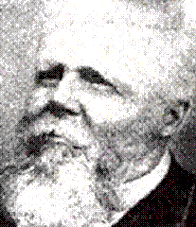
In 1867 the school consisted of three buildings, two of which were Antebellum cabins. As of 1875 when Shaw Collegiate Institute became Shaw University only two major structures existed – The Shaw Building and Estey Seminary. The former, erected where once stood corn fields in which Tupper hid from lynch mobs, with a 165-foot frontage, four stories high and possessing a tower, was the most commodious school building in all of North Carolina at that time. It provided instruction services, a library, and lodging. The seminary, reputed to be the first building ever erected for the education of African-American females, was devoted to training women in cooking, sewing, music, and the like. Henry Martin Tupper bought the material from which the women made garments and he himself sold the garments in an effort to pay for the cost of the material and other expenses.
In 1879, a third major building was erected – a chapel and dining hall called the Greenleaf Building. It was named for O.H. Greenleaf of Springfield, MA, a yearly liberal contributor. The upper part of the building was accessible by stairs. Doors on either side of the tower provided entrance to the dining room. At the right of the chapel was a small room and at the left a library. A storeroom existed under the stairway. Funds saved from the school were used to build this structure. These were augmented by contributions of $650 (15,116.28 in current dollars) from O.H. Greenleaf, Captain Ebenezer Morgan, and Deacon O.B. Grant of Stonington.
It was renamed Shaw Collegiate Institute after Elijah Shaw, benefactor of Shaw Hall, the first building. In 1875, it became Shaw University. In 1873, Estey Hall was built, marked the second female dormitory on the campus of a co-ed school in the United States. In 1866 when the Raleigh Institute was first being developed, Tupper had hoped to open a medical school; in 1881 the medical building became a reality, $15,000 (220,588.24 in current dollars) was contributed to make it. The medical school complex consisted primarily of three structures – a four-story medical dormitory built to accommodate 75 men and erected around 1880 when the trustees approved the establishment of a medical department; the Leonard Medical Building, erected in the summer and fall of 1881 and containing lecture rooms, dissecting rooms, an amphitheater, and opened for its first session on November 1, 1881; a 25-bed hospital which opened for the reception of patients on January 10, 1885. It was the first four-year medical school to train African-American doctors in the South.
On December 11, 1888 the university opened their law school. The full curriculum offering at Shaw are unknown, but it was the only black law school that had a course in legal shorthand. The course was offered on the premise that such a skill would broaden the opportunities for a black lawyer to work in a legal firm in a clerical position or as an office assistant should discrimination impede their ability to practice law. Shaw University graduated fifty-seven law students before it closed in 1916. It graduated fifty-four law students between 1891 and 1914.[4] North Carolina politician John S. Leary was an important figure in the founding of the law school served as its dean[5] starting in March 1890.[6] He was followed as dean by Edward A. Johnson, who was the law school's first graduate[7] and later the first African-American member of the New York State Assembly.

Leonard Medical School was founded in 1881 as the first four-year medical school in the South to train black doctors and pharmacists. The first medical school in the state to offer a four-year curriculum, it operated until 1918. Given their importance in United States educational history, both Estey and Leonard halls have been listed on the National Register of Historic Places. By 1900, more than 30,000 black teachers had been trained.[8]

In 1968, Shaw University became the first black college to own a radio station. At first, the station used an antenna on top of a building on the downtown campus, but in the late 1990s a new tower was built in southeast Raleigh near Interstate 40. WFSS in Fayetteville, North Carolina moved from 89.1 FM to 91.9 FM to allow WSHA to increase power. The university sold the station to Educational Media Foundation effective July 26, 2018, who subsequently renamed it WRKV.
U.S. Civil Rights Movement
The Student Nonviolent Coordinating Committee (SNCC) /ˈsnɪk/ was one of the organizations of the American Civil Rights Movement in the 1960s. It emerged from a student meeting organized by Ella Baker that was held at Shaw University in April 1960. SNCC grew into a large organization, gaining many supporters in the North as well as in the South. It led grassroots organizing for voter education and registration in Mississippi, among other initiatives.
1980s to present
By the mid-1980s, enrollment declined and the university was deeply in debt. President Talbert O. Shaw (1988–2003) (not related to the namesake) increased the student body from 1,600 to 2,700, restructured debt and created the Raleigh Business and Technology Center.
In the 1990s, Shaw ran a successful capital campaign to renovate historic buildings and construct new campus facilities, including the Talbert O. Shaw Center for Teachers' Education.
In 2005, Shaw University Divinity School (SUDS) received a 10-year accreditation from the Association for Theological Schools. The university also began construction on the Center for Early Childhood Education, Research and Development.
During the tornado outbreak of April 14–16, 2011, the university was struck by a damaging tornado, resulting in the school cancelling classes for a semester. As a result of the storm, two dormitories, the student union, and the roof of Estey hall were severely damaged.[9][10] There were minor injuries but no one was seriously hurt.
Study of World War II service of black veterans
Shaw University led a research study to investigate why no black veterans of World War II had been awarded the Medal of Honor. The study concluded that racial discrimination had contributed to the military's overlooking the contributions of black soldiers. The 272-page study recommended ten soldiers whose military records suggested they deserved the Medal of Honor. In January 1995, the team's findings were sent to the U.S. Department of Defense. In April 1996, the department agreed that seven of the ten soldiers should be awarded the Medal of Honor. All ten had been awarded other medals during the war years. President Bill Clinton awarded the Medals of Honor on January 13, 1997.
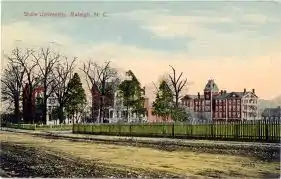
The department's decision in response to Shaw's study marked only the third time that the military re-evaluated military records to award the Medal of Honor. Only one of the seven nominees, 1st Lt. Vernon Baker of St. Maries, Idaho, was alive to receive his medal. Those who were awarded the Medal of Honor posthumously were: 1st Lt. Charles L. Thomas of Detroit, Michigan; Pvt. George Watson of Birmingham, Alabama; Staff Sgt. Edward A. Carter Jr. of Los Angeles, California; 1st Lt. John R. Fox of Boston, Massachusetts; Pfc. Willy F. James Jr. of Kansas City, Kansas; and Staff Sgt. Ruben Rivers of Tecumseh, Oklahoma. Their families received the medals.[11]
| Henry Martin Tupper | 1865–1893 | First/Founder |
| Nicholas Franklin Roberts | 1893-1894 (acting)[13] | |
| Charles Francis Meserve | 1894–1919 | |
| Joseph Leishman Peacock | 1920–1931 | |
| William Stuart Nelson | 1931–1936 | |
| Robert Prentiss Daniel | 1936–1950 | |
| William Russell Strassner | 1951–1962 | |
| James Edward Cheek* | 1963–1969 | |
| King Virgil Cheek* | 1969–1971 | |
| J. Archie Hargraves | 1971–1977 | |
| Stanley Hugh Smith | 1978–1986 | |
| John Lucas-Interim* | 1986–1987 | |
| Talbert O. Shaw | 1988–2002 | |
| Clarence G. Newsome | 2003–2009 | |
| Dorothy Cowser Yancy | 2009–2010 (interim) | |
| Irma McClaurin | 2010–2011 | |
| Dorothy Cowser Yancy | 2011-2013 | |
| Gaddis Faulcon | 2013-2015 (interim) | |
| Tashni-Ann Dubroy* | 2015–2017 | *Alumnus |
| Paulette Dillard | 2017–present |
Campus
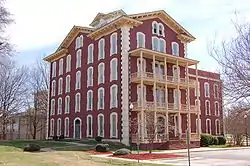
Shaw University consists of 32 buildings and nine additional campuses across the state of North Carolina. As of July 2011, Durham County Stadium will remain the home of the Shaw University Bears football team until construction plans towards building a new facility on Shaw Farm(a 40-acre lot donated to the University under James Cheek's administration on Rock Quarry Rd. in Raleigh NC and the site of the National Alumni House) is completed and implemented. The main campus is located in the heart of downtown Raleigh. Five of the thirty-two buildings are national and state historic landmarks which are the Frazier House, Estey Hall, Tyler Hall, Leonard Hall, and the Rogers-Bagley-Daniels-Pegues House. The University has a memorial garden in the heart of the campus which is also the location of the tombs of the founder of Shaw University, Henry Martin Tupper and his wife Sarah and the University bell tower, that was erected in honor of those who came and left the University, from its founding to its present.
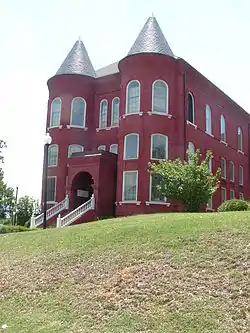
The University has three libraries, the James E. Cheek Library, the TOS Education Library, and the G. Franklin Wiggins Library, that houses over 210,000 volumes, 10,000 ebooks, many other sources of scholarly and cultural literature and microforms, located throughout Shaw University (including CAPE sites). The Raleigh Business and Technology Center is located on Shaw's campus. Planned in 1989, Shaw University city council officials and Saint Augustine's College in a joint effort built the current facility on Shaw's Campus. Both colleges use the center for classes and community programs. The Campus has four dorms, the Flemming-Kee Men's Dorm, the Dimple Newsome Dorm, Talbert O. Shaw Men's Dorm and the Talbert O. Shaw Women's Dorm. Other resources available on or adjacent to the campus are McDonald's, The Willie E. Gary Student Center which houses the Bear's Den (Game Room and Grill), and the Cyber Cafe'.
Academics
Accreditation
Shaw University is accredited by the Southern Association of Colleges and Schools, the Council on Social Work Education, and the American Psychological Association. The Divinity School is accredited by the Association of Theological Schools in the United States and Canada as its Allied Health Professions programs are accredited by the Commission on Accreditation of Allied Health Education Programs, the Commission on Accreditation of Athletic Training Education, and the National Council for Accreditation of Teacher Education.
The Center for Alternative Programs in Education (CAPE) has centers in Greenville, Kannapolis, High Point, Rocky Mount, Ahoskie, Fayetteville, Durham, Wilmington, and Asheville.[14]
Academic Divisions
As of the 2020-2021 school year, Shaw consists of the following schools:
- School of Arts and Sciences
- School of Business and Professional Studies
- School of Divinity
Undergraduate Curriculum
Shaw offers 21 arts and sciences majors for degrees in Bachelor of Arts (B.A.) or Bachelor of Science (B.S.). Shaw also offers a non-degree teaching certificate for individuals who have earned a bachelor’s degree or higher in education or related major and wish the fulfill the requirements to obtain a teaching license. The majority of students enroll in the School of Arts and Sciences and the School of Business and Professional Studies.
Athletics
Shaw University is a member and co-founder of the National Collegiate Athletic Association Division II's Central Intercollegiate Athletic Association (CIAA) Conference. Shaw University's Basketball team participates in the CIAA annual Basketball Tournament, which is the third most attended athletic event in collegiate sports after the Atlantic Coast Conference and Big East tournaments . Shaw fields 14 varsity athletic teams including teams in men's soccer, women's soccer, men's basketball, women's basketball, football, tennis, baseball, cheerleading, men's and women's track and field, volleyball, golf, and bowling. The athletic teams are known by the "Bears" nickname.
In 2002, Shaw University's men's basketball team won the CIAA championship. Also, the ladies' basketball team won the 2003 CIAA championship. The football team, reestablished by Clarence G. Newsome in 2002, played at Durham County Memorial Stadium in Durham, North Carolina, through the 2008 season. In 2009, the team relocated their home games to Millbrook High School in Raleigh. The Bears currently play at Durham County Stadium.[15] It won the CIAA football championship in 2004, 2007, 2008, and 2010.[16] The football team has also made the Division II playoffs in 2007 and 2010. Also in 2011 both men's and women's teams won the CIAA Tournament making Shaw the last school since Norfolk State in 1975 to win the big three championships in the same year. Shaw's Lady Bears won the NCAA Division II Championship for the 2011-2012 season. The Shaw University Lady Bears have won the CIAA Tournament four years in a row twice (2003-2006) (2011-2014). Their most recent win occurred on March 1, 2014.
The Bears have won a total of 60 CIAA championships between men's and women's basketball, men's and women's tennis, football and volleyball.
Student life
Greek Organizations
- The Delta Psi chapter of Omega Psi Phi fraternity
- The Delta Gamma chapter of Kappa Alpha Psi Fraternity Inc
- The Beta Rho Chapter of Alpha Kappa Alpha Sorority, Inc.
- The Alpha Rho chapter of Delta Sigma Theta sorority
- The Beta Rho chapter of Alpha Phi Alpha fraternity
- The Gamma Tau chapter of Iota Phi Theta fraternity
- Omicron chapter of Zeta Phi Beta sorority
- Iota chapter of Phi Beta Sigma fraternity
Student organizations
Shaw University's quiz bowl team competed in the national Honda Campus All-Star Challenge tournament in 2015.[17] The University has a range of student organizations:[18]
- Shaw University ACM Student Chapter
- Pure Elegance (Plus size fashion society)
- The Shaw Players and Company
- Student Government Association
- Shaw Computer Club
- Gospel and University Choirs
- Jazz, Pep, and Concert Bands
- COGs (Children of God)
- Honda Quiz Bowl Team
- Shawensis Literary Club
- Student North Carolina Association of Educators
- Pre-Alumni Council
- Shaw Man/Shaw Woman Society (Organizations that emphasize development of character)
- Psychology Club
- Swing Phi Swing
- Shaw University National Alumni Association
- Free Masons and the Order of the Eastern Star
- Religion and Philosophy Club
- Groove Phi Groove
- Iota Alpha Omega Christian Fraternity
- National Association for the Advancement of Colored People
Marching band
Shaw's marching band, better known as "Platinum Sound", was reestablished in the Fall of 2002 along with the reestablishment of the football team. The band has grown from 80 members in 2002 to over 130 members. Shaw's marching band has participated in the Honda Battle of the Bands at the Georgia Dome in Atlanta, Georgia.
Notable alumni
| Name | Class year | Notability | Reference(s) |
|---|---|---|---|
| Roger Demosthenes O'Kelly | 1909 | Lawyer, first deaf and black lawyer | [19] |
| Gladys Knight | 1966 | Singer, Gladys Knight & the Pips, member of the Rock and Roll Hall of Fame, received Honorary Doctorate | [20] |
| Adam Clayton Powell, Jr., D.D. | 1934 | Congressman from New York, 1945–71 | [21] |
| Richard Gene Arno | Founder of the National Christian Counselors Association | ||
| James B. Dudley | 1881 | Professor; President of NC A&T (1896–1925) | |
| Edward A. Johnson | 1891 | First African-American member of the New York state legislature | |
| Ezekiel Ezra Smith | 1880 | U.S. Ambassador to Liberia (1888–1890) and President of Fayetteville State. | |
| Lenard Moore | 1980 | First African American President of the Haiku Society of America | |
| Ella Baker | 1927 | Leader of SNCC and civil rights activist | |
| Charlie Brandon | 1967 | Grey Cup champion and all-star CFL football player | |
| Edward C. Dolby | 1966 | Former Carolinas President, Bank of America | [22] |
| Angie Brooks | 1949 | Former President of the United Nations General Assembly and Associate Justice to the National Supreme Court of Liberia | [23] |
| Shirley Caesar | 1984 | Pastor and gospel music artist | |
| Henry Plummer Cheatham | 1883 | Republican member of the United States House of Representatives from 1889 to 1893. | |
| James E. Cheek | 1955 | Former President of Shaw University, President Emeritus of Howard University, 1983 recipient of the Presidential Medal of Freedom. | |
| Willie E. Gary | 1971 | Multi-millionaire attorney and co-founder of the Black Family Channel | |
| Van Green | 1973 | NFL player | |
| Julius Gregory | 2011 | Arena Football League player | |
| Edward A. Johnson | 1882 | First African-American member of the New York state legislature when he was elected to the New York State Assembly in 1917. | |
| Lee Johnson | 1975 | President & CEO of Mechanics & Farmers Bank | |
| Lords of the Underground | Attended | Hip-Hop Group that was founded in the early 1990s, when all three of its members were students attending Shaw University | |
| Luther Jordan | 1997 | Former member of the North Carolina Senate from 1993 to 2002 | |
| Edward Hart Lipscombe | 1879, 1882 | Educator, minister, principal of the Western Union Institute | |
| Vernon Malone | 1953 | Democratic member of the North Carolina General Assembly, 14th Senate district, including constituents in Wake County | |
| Lee Monroe | 1970 | Former President of Voorhees College | |
| Peter Weddick Moore | 1887 | First President and Founder of Elizabeth City Normal College, (now Elizabeth City State University) | [24] |
| John O. Crosby | 1914 | First President & Founder of North Carolina A&T | [25] |
| Shelia P. Moses | 1983 | Best selling author, nominated for the National Book Award & NAACP Image Award | |
| Ronald "Flip" Murray | 2002 | Professional basketball player | |
| Celeste Beatty | 1984 | First Black Female Brewery Owner | |
| Eleanor Nunn, Ph.D. | Civil rights activist (one of founders of SNCC) and educator, North Carolina State University | ||
| William L. Pollard | 1967 | President of the Medgar Evers College (2009–2013) | |
| M. T. Pope | 1886 | Prominent physician in Raleigh; ran for mayor in 1919. His home is listed on the National Register of Historic Places and is a museum | |
| Benjamin Arthur Quarles | 1931 | Historian, administrator, scholar, educator, and writer. | |
| James E. Shepard | 1894 | Founder and President of North Carolina Central University | [26] |
| William Gaston Pearson | 1886 | Educator and businessman, co-founder of Mechanics & Farmers Bank, an African-American Bank in Raleigh, North Carolina | |
| William R. Pettiford | 1912honorary | Birmingham, Alabama minister and banker | |
| Charles L. Purce | President of Selma University and Simmons College of Kentucky | ||
| Ida Van Smith | 1939 | One of the first African American female pilots and flight instructors in the United States | |
| Edawn Coughman | 2010 | Offensive Lineman and OT for the Buffalo Bills | [27] |
| James "Bonecrusher" Smith | 1975 | First heavyweight boxing champion with a college degree | |
| Rita Walters | 1952 | Currently serves on the Board of Library Commissioners for the Los Angeles Public Library | |
| Lucius Walker | 1954 | Baptist minister best known for his opposition to the United States embargo against Cuba | [28] |
| Col. James H. Young | 1882 | First African American to hold the rank of colonel in the United States of the volunteer regiment during the Spanish–American War | |
| Max Yergan | 1914 | Civil Rights activist; Spingarn Medal recipient | |
| Angie Brooks | 1950 | The only African female President of the United Nations General Assembly | |
| Glenford Eckleton Mitchell | 1960 | Member of Universal House of Justice (1982–2008) | |
| Louise Celia Fleming | 1885 | Black medical missionary (1862-1899) | [29] |
References
- "Shaw University". U.S. News Best Colleges. U.S. News. Retrieved 2020-11-18.
- "About Shaw University". Archived from the original on February 13, 2008. Retrieved March 1, 2008.
- "Tabernacle Baptist Church official website". Archived from the original on May 9, 2008. Retrieved May 29, 2008.
- Smith, John Clay (1999). Emancipation. ISBN 0812216857. Retrieved 15 August 2015.
- Whitted, Fred. Fayetteville, North Carolina, Arcadia Publishing, 2000, page 15
- Colored Law School, The State Chronicle (Raleigh, North Carolina) March 30, 1890, page 3, accessed October 10, 2016 at https://www.newspapers.com/clip/6968010/colored_law_school_the_state_chronicle/ Archived 2016-10-11 at the Wayback Machine
- Sheppard, Steve. The History of Legal Education in the United States: Commentaries and Primary Sources. Vol. 1. The Lawbook Exchange, Ltd., 1999. p454
- Anderson, James D. (1988). The Education of Blacks in the South, 1860–1935. Chapel Hill: University of North Carolina Press. pp. 244–245.
- "Shaw Campus Hit By Raleigh Storm; No Injuries". News & Events. Shaw University. Archived from the original on 2012-11-15. Retrieved November 5, 2012.
- McClaurin, Irma (April 17, 2011). "Message from President McClaurin: A Prayer for Hope in the Face of Disaster" (PDF). Shaw University. Archived (PDF) from the original on 2012-08-14. Retrieved November 5, 2012.
- "Historical Perspective". World War II Study. Shaw University. Archived from the original on April 22, 2008. Retrieved May 29, 2008.
- Carter, Wilmoth. A, Shaw's Universe, 1989 Tapestry Press
- Chang, Derek. Citizens of a Christian nation: Evangelical missions and the problem of race in the nineteenth century. University of Pennsylvania Press, 2011. p147
- "CAPE Adult Degree Program". Shaw University. Archived from the original on 2014-03-20. Retrieved April 23, 2014.
- "Shaw University To Play Football At Millbrook High School". Retrieved January 5, 2010.
- "CIAA". Archived from the original on 2015-09-05. Retrieved 15 August 2015.
- "Shaw University students to compete in quiz-bowl tournament". newsobserver. Archived from the original on 2016-08-03. Retrieved 2016-06-08.
- "Student Organizations - Shaw University". www.shawu.edu. Retrieved 2021-01-01.
- "Full text of "Shaw University Bulletin: Alumni Number with Founder's Day Announcements"". Raleigh (N.C.): Shaw University. 1962. Retrieved 15 August 2015.
- "Gladys Knight Biography". Archived from the original on 2016-01-07. Retrieved 15 August 2015.
- Adam Clayton Powell. "Adam Clayton Powell - Notable Names DataBase (NNDb)" Archived 2014-03-07 at the Wayback Machine, Notable Names Database, September 11, 2001. Accessed March, 2014.
- Shaw U Alumni. " Shaw University - Notable Names DataBase (NNDb)" Archived 2013-10-02 at the Wayback Machine, Notable Names Database, Accessed March, 2014.
- "The Bear". North Carolina Yearbooks. Shaw University: 23. 1949.
- [Elizabeth City State Archives "Archived copy" (PDF). Archived from the original (PDF) on 2014-03-20. Retrieved 2014-03-20.CS1 maint: archived copy as title (link)]
- Presidents & Chancellors. "NC A&T Library" Archived 2014-03-18 at the Wayback Machine, May 29, 2009. Accessed March, 2014.
- ITS Web Services. "Past Presidents and Chancellors". Archived from the original on 2015-09-05. Retrieved 15 August 2015.
- http://espn.go.com/nfl/player/_/id/15700/edawn-coughman Archived 2014-07-08 at the Wayback Machine Edwan Coughman - ESPN.go.com
- Martin, Douglas. "Lucius Walker, Baptist Pastor for Peace, Dies at 80" Archived 2018-01-25 at the Wayback Machine, The New York Times, September 11, 2010. Accessed September 12, 2010.
- "Fleming, Louise Celia "Lulu" (1862-1899)". BlackPast.org. 2014-02-10. Archived from the original on 2018-02-13. Retrieved 12 February 2018.
Additional references
- Carter, Wilmoth A. Shaw's Universe: A Monument to Educational Innovation, Raleigh: Shaw University, 1973
- Lincoln, C. Eric, The Black Church in the African American Experience, Durham: Duke University Press, 1990
External links
| Wikimedia Commons has media related to Shaw University. |
- Official website
- Official athletics website
- SNCC, 1960–1966: Six Years of the Student Nonviolent Coordinating Committee

